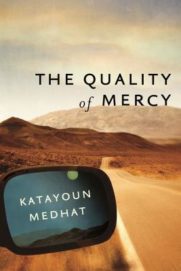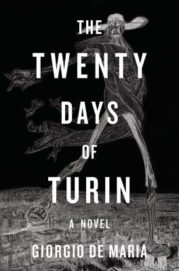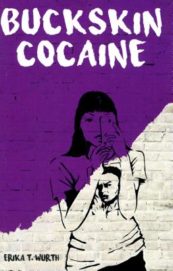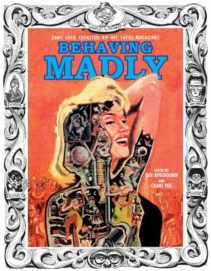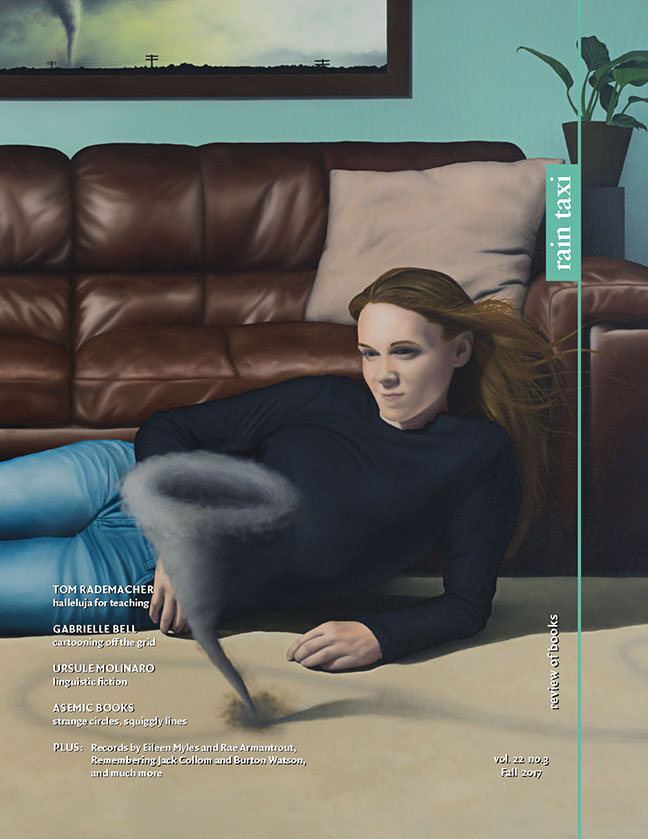INTERVIEWS
Discovery in Darkness: An Interview with Samanta Schweblin
Argentinian author Samanta Schweblin discusses her influences and her work, including her recently translated short novel, Fever Dream.
Interviewed by Allan Vorda and Liliana Avila
Created Identities: An Interview with Elvira Navarro
Spanish author and avant-gardist Navarro discussed her new novel, soon to be translated in English, La Trabajadora. Interviewed by Jorge Armenteros
The Holiness of the Alphabet: An Interview with Janet Hamill
The New Jersey surrealist, trance poet, and rock ’n’ roller Janet Hamill is a true American original, an amalgam of disparate parts. Interviewed by Bob Holman
FEATURES
Chinese Poetic Writing by Francois Cheng
A Little Primer of Tu Fu by David Hawkes
Two recent reissues celebrating classic Chinese poetry will ignite intense admiration and unlock a rich toolbox for any working poet. Reviewed by Patrick James Dunagan
CHAPBOOK REVIEWS:
Hectic Pigment
Jed Rasula
Rasula’s sharply sculpted volume of six poems shows the influence of the Dada and Surrealist precursors he’s written about so lucidly. Reviewed by James Cook
POETRY REVIEWS:
Afterland
Mai Der Vang
Hmong-American poet Mai Der Vang explores the emotional turmoil of displacement, exile, and the difficulty of inventing a new home in the “afterland.” Reviewed by John Bradley
Historians of Redundant Moments
Nandini Dhar
Dhar’s novel-in-verse is a brilliant conglomeration of most of the things that make us human. Reviewed by D.M. Aderibigbe
Groundspeed
Emilia Phillips
In her newest collection, Phillips addresses the wounds a body collects throughout a lifetime, along with themes of death and coming of age. Reviewed by Krystal Languell
Fast by Jorie Graham
Debths by Susan Howe
Both Fast and Debths come from an eerie and elemental no one’s land of late-stage collections—inciting a poetry that generates its own anxiety of influence, its own metaphysical stakes, its own mode of being-in-the-world. Reviewed by Kevin Carollo
Holy Ghost
David Brazil
Holy Ghost expresses the ideological cacophony of our times and juxtaposes it against the simplicity of human need. Reviewed by David Nilsen
MIXED GENRE REVIEWS:
Antígona González
Sara Uribe
At a time when the discourse of “bad hombres” and “building a wall” has poisoned U.S. society, Mexican writer Sara Uribe’s Antígona González emerges as an anti-toxin.
Reviewed by Gabrielle Civil
I’m So Fine: A List of Famous Men & What I Had On
Khadijah Queen
Queen takes up themes of fashion, attraction, and self-actualization in her new collection of episodic lyric pieces. Reviewed by Jeremiah Moriarty
FICTION REVIEWS
Endgame
Ahmet Altan
The Turkish author's first novel available in English is a bold metaphysical thriller, critical not only of ruthless politicians, but also, arguably, of God himself. Reviewed by Garry Craig Powell
Since I Laid My Burden Down
Brontez Purnell
Purnell’s unconventional novel is ultimately concerned with how one’s masculinity is shaped by the presence and absence of other masculinities. Reviewed by Greg Baldino
The Consequences
Niña Weijers
Weijers’s ambitious debut novel explores everything from the role of art in documenting existence to predestination, the nature of freedom, and the Mayan view of Time. Reviewed by Garry Craig Powell
The Quality of Mercy
Katayoun Medhat
A police officer, an outsider to the Southwest, works to solve the murder of yet another young Navajo man as feelings of distrust mount among people who depend on each other. Reviewed by Jackie Trytten
Buckskin Cocaine
Erika T. Wurth
Wurth’s new collection of short stories depicts the Native film industry in the voices of different tribe members. Reviewed by Zack Kopp
The Twenty Days of Turin
Giorgio De Maria
In his expression of existential-social terror, De Maria joins writers such as Lovecraft and Poe in crafting a peculiarly literary kind of horror. Reviewed by Rick Henry
ART REVIEWS
Eduardo Paolozzi
Edited by Daniel F. Herrmann
Since his death in 2005, Eduardo Paolozzi's reputation as one of postwar Britain's most versatile, productive, and celebrated visual artists has been enhanced by books such as this. Reviewed by M. Kasper
NONFICTION REVIEWS
Tell Them I Said No
Martin Herbert
This slim but forthright volume of essays provides a welcome glimpse into the impulse to resist the neo-liberalization of art in the interest of maintaining human dignity. Reviewed by Michael Workman
Teacher: Two Years in the Mississippi Delta
Michael Copperman
This memoir on the difficulties and despair surrounding a young teacher’s attempt to enable positive change in a poor Mississipi school district is handled with deeply reflective and unflinching honesty. Reviewed by T. K. Dalton
Elizabeth Bishop: A Miracle for Breakfast
Megan Marshall
Marshall’s research and smooth, concise storytelling make this book both an empathetic biography and an insightful analysis of an artist who sought “a way of thinking with one’s feelings.” Reviewed by Edward A. Dougherty
Loving Robert Lowell
Sandra Hochman
This flawed but heartfelt memoir details the brief relationship between Hochman and Lowell in the early 1960s. Reviewed by Brooke Horvath
The Gene Machine: How Genetic Technologies Are Changing the Way We Have Kids—and the Kids We Have
Bonnie Rochman
Rochman explores the advancements of genetic testing and our emotional responses to a plethora of information not only about our own genomes, but our children’s. Reviewed by Victoria Blanco
Kill All Normies: The Online Culture Wars from Tumblr and 4chan to the Alt-Right and Trump
Angela Nagle
Irish journalist Angela Nagle elucidates the circumstances that fomented the rise of the right-wing social media movement. Reviewed by Alex Kies
COMICS REVIEWS
Behaving Madly: Zany, Loco, Cockeyed, Rip-Off Satire Magazines
Ger Apeldoorn & Craig Yoe
Illustrated by Jack Davis, Al Jaffee, & Jack Kirby
Opening this wonderfully odd volume, we find ourselves plunged into the vanished pulp world of the 1950s and the rise of wacky humor. Reviewed by Paul Buhle
Rain Taxi Online Edition Fall 2017 | © Rain Taxi, Inc. 2017

